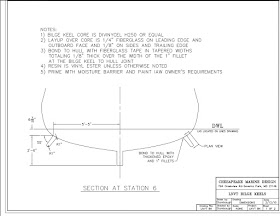Here are the bilge keel drawings John Niccolls commissioned for Knock Off 37VT66.
A red-lined drawing (i.e. after the fact) would show that Knock Off's bilge keels were installed farther underwater and the forward, aft and distal ends are square, i.e. don't have a parabolic taper.
John Mackie, John William 37VT68 is considering bilge keels and his research has uncovered the following. Concave surfaces on both the top and bottom faces of the bilge keel increase roll resistance (as compared to a flat plate).

Putting holes through the keel will also increase roll resistance. The idea here is that, with properly sized holes, the drag of the water through the length of the hole is greater than the decreased drag because of the hole's presence.
Disrupting the flow at the bilge keel's distal end will also increase roll resistance.

Of the two shapes above it would be interesting to know which is more effective. Certainly increasing the size of the plate, up to an extent, will increase roll resistance.
John Mackie points out that from a one-off, manufacturing perspective, the concave plate with a flat, metal plate on the distal end is easier to make when using glass mat, foam and Marine plywood.
When I last spoke to John M he hoped to make concave keels. The approach will be to sandwich foam around Marine plywood.

The inner layer is ~1" thick plywood while the two outer layers are foam. The whole thing will be encapsulated in fiberglass.
I hope we can keep this conversation going. There's a lot to be learned and I know some tugs that are available as Guinea pigs ;-)
Take care, Dave





No comments:
Post a Comment